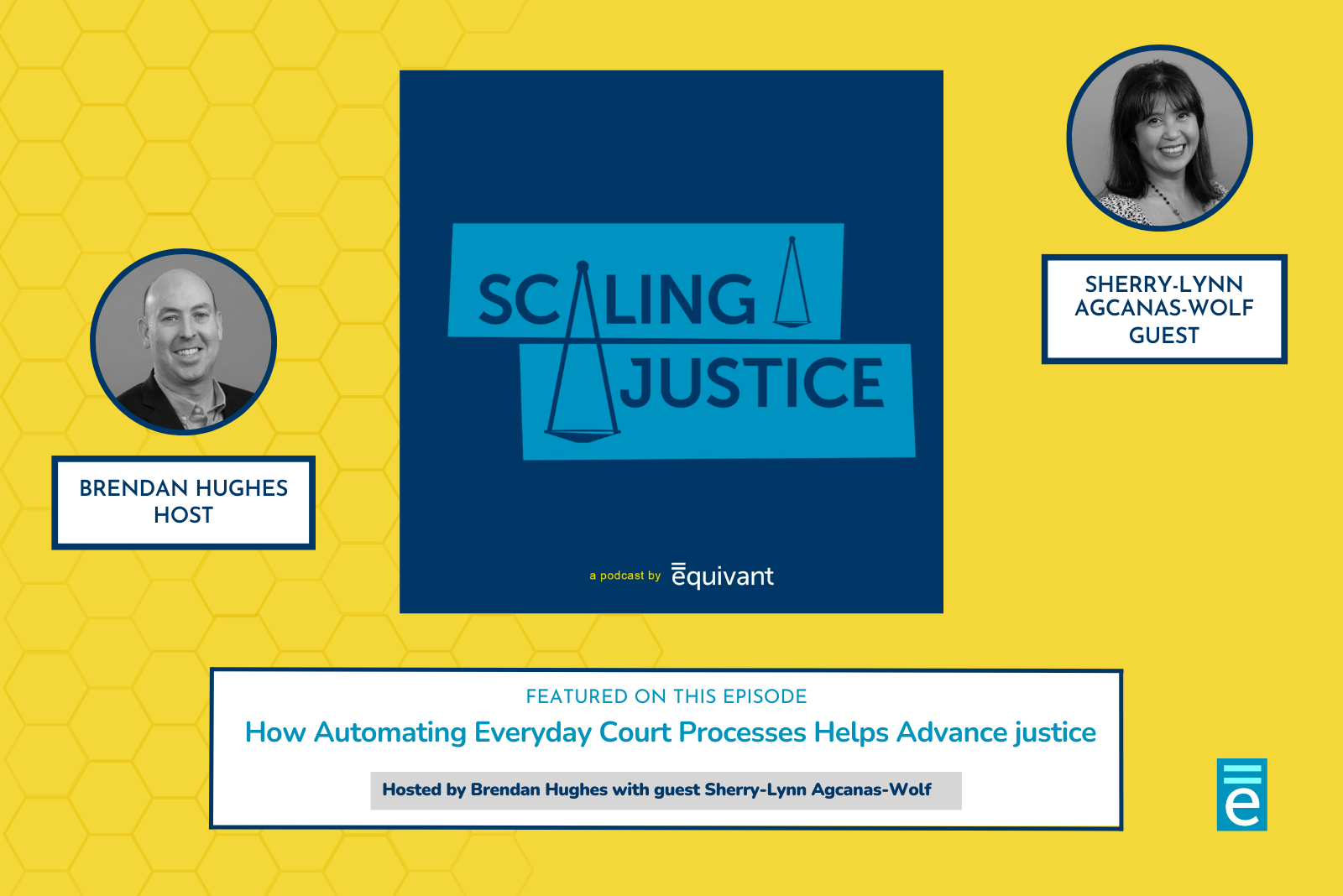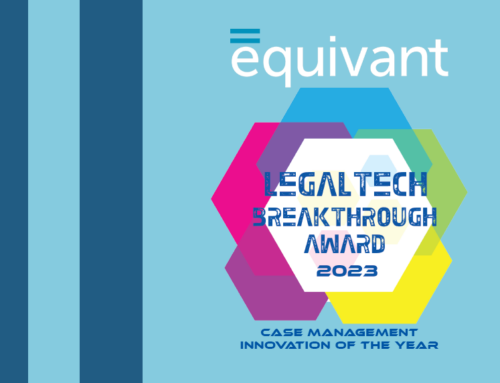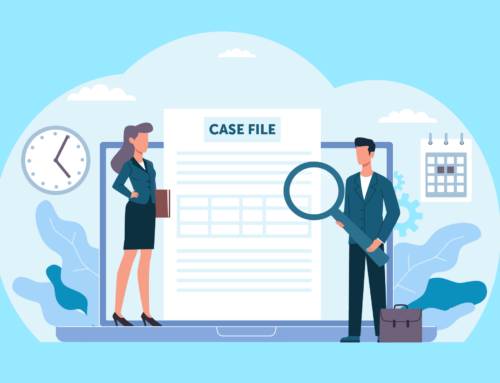How Automating Everyday Court Processes Helps Advance Justice
Scaling Justice • An equivant podcast

Get out of the file drawer and into automated case management systems (CMS) with equivant’s Sherry-Lynn Agcanas-Wolf.
The pressures of going virtual can be overwhelming for courts plagued by staffing shortages, limited budgets and resources, and increased demand for services. But the ability to automate CMS processes is safe, secure, and a technology that has been around for years. On Scaling Justice, we speak with Sherry-Lynn Agcanas-Wolf, who has spent over 20 years helping courts run more efficiently. In this podcast, she explores how courts benefit from innovative solutions to simplify their case management and workflow systems.
Watch now:
Tune in:
Scaling Justice Podcast Transcript
| Episode 11: How Automating Everyday Court Processes Helps Advance Justice
Guest: Sherry-Lynn Agcanas-Wolf |
Introduction to Podcast:
[00:00:01.190] – Brendan
Hello, and welcome to Scaling Justice, a video podcast by equivant that operates at the forefront of the justice space. The American justice system is multifaceted, and oftentimes complex but with each new episode, we want to explore best practices and innovations that not only help advance justice but also impact all of us as practitioners, technologists, and even as members of our communities.
Introduction of Episode Topic:
I’m your host, Brendan Hughes, and I work with equivant to help build more efficient, effective, and equitable justice agencies nationwide. One of the pressures that courts face today is using technology to end bottlenecks caused by staffing shortages, limited budget or resources, and increasing demand for services. The evolution of court systems is nothing new, and we’ve seen big changes before with legislative proposals or new business processes. But the past few years have been especially noteworthy with a focus on technological innovation unlike before.
On today’s episode of Scaling Justice, we speak with Sherry-Lynn Agcanas-Wolf who has worked with both the technology available to courts and the outside influences they must respond to and she says the ability to automate some CMS processes has been around for years. Sherry believes many more courts could benefit from the opportunity to create seamless electronic processes that get files off desks and staff out of back rooms so they can advance justice as efficiently as possible.
Greetings:
[00:01:44.850] – Brendan
Welcome to the podcast Sherry, thank you for joining us today. So let’s kick off today’s discussion with you telling us a little more about your role at equivant.
[00:01:53.390] – Sherry
Okay. So I am a product portfolio manager. I’ve actually had multiple roles here with equivant. I’m in my 22nd year. And my purview of the world is that I concentrate on the case management system, of which we have several. You probably know that if you don’t. And my goal is to make sure our CMS is the best of breed. That with product, I want to ensure that we’re competitive in the market space. We have all the functionality that we need to have, and we continue to evolve and improve our case management system with the trends and the changes in the court system.
Interview:
Right. And you must have seen a lot in the past 22 years, a lot of changes. Have the past two or three years been especially significant, or has it just been evolving all along?
[00:03:03.980] – Sherry
It’s always been evolving in the past few years. It’s been concentrated on technology more so than any other time. There’s been places where the business processes change significantly, especially when there’s certain legislative reform across the nation. When we went through bail reform, we’re still kind of going through bail reform. When going through certain scenarios like that, you’ll see big changes. But these past few years have been about technology because that was the way that most of our courts needed to communicate, strictly through technology and not through the regular channels of walking into the court house.
[00:03:50.750] – Brendan
Right, that makes a lot of sense. equivant released a white paper, “Simplifying Court and Case Management in 4 Steps: How to Maximize Court Efficiency by Combining Technology with Workflow Tactics”, late last year. In addition to those tech changes that are happening right now, are there other widespread changes that might influence why equivant would want to discuss workflow and court management?
[00:04:12.650] – Sherry
Much of it is around the technology because workflow is about making sure that the courts are more efficient, especially if there’s less staff, especially if they can’t go through their regular paper processes that they may normally do. They move things to electronic triggers. And when that happens, then those types of triggers can happen silently. So you don’t have a piece of paper landing on your desk. You don’t have the case file moving from room to room to room. So usually that’s your trigger. And so what workflow does is it comes in and monitors those electronic triggers that used to be paper and then does the action that a clerk normally would have done if it dropped into their inbox, makes them a lot more efficient and allows them to not be mired by electronic cues. Same thing as, like, an email inbox or that type of thing. Your inbox is getting so large that you can’t attend to it. So it automates those incoming messages, incoming triggers. So we can do the action, we can program it to do the action that they would do.
[00:05:52.710] – Brendan
And what are some of those triggers or actions that you’re referring to?
[00:05:56.770] – Sherry
That’s a great question. So things like a particular document came in through electronic filing. Then the next step could be that it needs to be served out to the participants on the case so that process can be automated. And instead of waiting for someone to pick up that piece of paper because it came in through paper filing, they’ve got to process that document through the system. Then they’ve got to create the service notification, print that out, stick it in an envelope, send it off. We do that kind of automatically. Right. It comes in electronically. It creates that notice electronically. It sends an email out to the participants automatically. And so it becomes a seamless process and very little friction and touching of the system for our end users. And that’s really what workflow means, is that you have a business process that happens based on a trigger and that process can go all the way through and doesn’t need a lot of user interaction because it knows what to do. You’ve already told it what to do.
[00:07:21.070] – Brendan
Right. Going back to the white paper, who are the people in the courts you envision using the white paper to create their workflows and automate their processes?
[00:07:31.560] – Sherry
Yeah, so I would see a supervisor of division. So, like a supervisor of a division of criminal cases, of civil cases, that type of person? IT. A court administrator.
[00:07:49.910] – Brendan
All right, and then who else do you think could benefit from this technology?
[00:07:53.750] – Sherry
Absolutely. So you would probably see, like, judicial staff get involved with that. Sometimes the judicial staff and judges. Sometimes judges may not, they’ll look at it and go, ‘no,’ because it is very technical and it’s not about decision making, it’s really about things moving around. But the judicial staff would be a person that would be involved with that and then the clerk staff.
Because they’re the ones that actually do the work.
[00:08:31.860] – Brendan
Right, great. So why then is efficiency important for courts right now? And I’m really interested in what you’re hearing directly from equivant clients about why this matters to them.
[00:08:45.130] – Sherry
So some of it is that with staff, so there’s less staff than usual, there’s less staff in the courthouse. So I never thought I would see it. But court staff is now distributed and working remotely. And so when you’re not in the office, technology becomes increasingly important. The electronic triggers, like I said before, become more important. And you don’t want to be bombarded by your outside services like email inbox. Right. You want your CMS, your case management system, to be monitoring those triggers. So it could be staff because there’s less staff, or it could be that they’re distributed. So that is the reason why workflow efficiency is important also because there’s still an increase in caseload, especially in certain parts of the court system.
[00:10:10.130] – Brendan
Where is that increase coming from?
[00:10:12.790] – Sherry
So you’ll see that in your foreclosures.You’ll see that in some of your misdemeanors. There’s a trend right now where tickets are now decriminalized. And so there’s a lot more people interacting with the court in a different way before they’d have to go to the courthouse and do their processes. Now that’s all moved out to, ‘I need to look up a case, I need to pay my ticket online, I can do that.’ There’s an increase there for that.
Yeah. So technology is truly almost necessary. Just the way we communicate is through electronic means and the way that people are interacting with the court is now through an electronic means.
[00:11:28.160] – Brendan
Yeah, that makes sense. So is this going to be a big change for a lot of courts? How many courts are using these kinds of automated workflow tactics?
[00:11:39.070] – Sherry
Very little. So the pandemic caused most of our courts, kind of forced them to fast track their electronic processes so that before they may not have done any online filing at all, or online payments. And now they had to do online payments, online filings in order to continue to process their cases.
I’ve seen some workflow in systems, but they’ve been manual, so they’ve only been like one step, one trigger, one step. And workflow really means that you’re doing multiple actions and you’re not just accepting the online e-filing document, you’re going all the way through the process.
So you’re serving the participants at the end of it.
[00:12:50.950] – Brendan
Why do you think it has taken this long for courts to adopt these systems?
[00:12:54.810] – Sherry
I think the resistance before was a distrust in technology and security.
All right, so that is probably the biggest piece. I think there’s always going to be some monetary issues there from some courts. Some courts are really small. But if you can’t get past the distrust that what the courts are doing online is safe and secure, they could have all the money in the world and they still won’t go forward with that.
[00:13:32.370] – Brendan
Right. So systems administrators and court officials are understandably concerned about the safety and security of their systems; what would you say to them to allay their concerns about adopting a new system?
[00:13:46.890] – Sherry
A great question, because this is what we talk to our judges, our court administrators, our IT staff all the time. We’ve been in this business over 30 years and we’ve been using a web based product for over 20 years, okay. Where our customers are accessing all their case information through an Internet browser. We understand security. We understand why safety is important because we’ve done this from green screen all the way to web browser, all the way to hosted. And hosted is another newer technology for our courts where they don’t have the servers on site. It’s all in the cloud. And again, that’s another, it’s all about trust that their data is secure, their information is secure.
[00:14:43.130] – Brendan
So you have every bit of confidence in the systems and controls that you have in place?
[00:14:47.870] – Sherry
Yes. And then technology has been there for quite some time.
[00:14:52.350] – Brendan
So it’s not new technology. It’s tested technology.
[00:14:55.970] – Sherry
It is tested technology. So when it comes to security, yes. And even workflow is newer for our court, it’s not necessarily newer for the case management system.
[00:15:11.890] – Brendan
Okay. Do you have any examples of courts successfully integrating their workflow and technology to positively impact their operations?
[00:15:20.630] – Sherry
Yeah, we have some municipal courts that are doing workflow because they’re a smaller court, smaller staff, volume is high. And so in order for them to get through their caseload efficiently, they’ve created workflows to do the repetitive steps that a clerk would normally do that we can program and have the system do for them.
[00:15:55.730] – Brendan
And so how does it work? Do you guys work with folks hand-in-hand to help them do this, or is this something they’ll take the white paper and figure it out on their own? Or does it work either way?
[00:16:07.140] – Sherry
Normally, there’s two steps to it. So the first step, we’ve always tell our courts they need to look at their business processes. They need to see how their cases go through the process. Why is it going to someone’s desk, the clerk’s desk? Why does that case fall now? Go to the judges and follow that process through. They can then work with their vendor, the CMS vendor, to see what parts can we automate? It could be all of it. There might still be pieces there that we can’t always automate because we have to wait for … there may be legislation that says you need a wet signature. We can identify that. We can identify those pieces with them. So normally we work hand in hand with our customers, but we also say you can do work now without your vendor. You can go through and start analyzing your business processes and see if there’s any bottlenecks, if there are any places in your processes where you don’t know what the next step is. And we can be tracking that next step for you.
[00:17:32.530] – Brendan
Okay. What are the top lessons that you want courts to take from the White Paper?
[00:17:37.360] – Sherry
Yeah, [the] top is analyzing your business processes. That is at the top of the list. And the reason why we say that is many times our processes could be based on workarounds that we’ve created because we did not have technology.
[00:18:01.370] – Brendan
Do you have any examples of that?
[00:18:03.100] – Sherry
Sure. So in many case management systems, there are things called, there’s due date trackers, for example, and there are aging mechanisms, so I’ll talk about those too. So due date trackers, most cases have a specific timeline guideline that they have to follow, and when it doesn’t happen, there should be some type of notification. But if it’s all paper then what they’re doing is that their tickler or their trigger is actually a case file drawer. And they know they need to check that case file drawer once a week, once a day. And they’ve always done that because they don’t realize there’s a time tracking mechanism inside their case management system.
[00:18:59.260] – Brendan
Got it. So you don’t have to check the drawer every day?
[00:19:02.720] – Sherry
No, you don’t have to. And you don’t have to have your paper case files stacked up beside your desk because you don’t want to miss out that you’re going to lose one of those files or miss the date. Because if you do miss the date, then that can change how cases are prosecuted because like I said, there’s a timeline. So there’s a concept in the criminal world of speedy trial, so you have to hit these milestones within a case in order to complete the case in a timely fashion and not have that case be dismissed on grounds or you end up in an appeal court.
[00:19:44.030] – Brendan
Right. So instead of having to check the files and do those sort of mundane things, what else could the court personnel be doing instead while the CMS and the workflow are working together to make everything automated? What does that time give them or what could they be doing instead?
[00:20:02.210] – Sherry
That is a hard question to answer, right? But certainly we’ve all experienced how slow cases can progress and how busy courthouses can be. And when we streamline these processes or when we go through these workflows and things are automated that could possibly lessen your foot traffic inside the courthouse, especially when it comes to things like filings, that can all be automated. And all that communication is all done through technology. There’d be no reason for the person to be in your courthouse.
[00:20:50.020] – Brendan
And that just means a quicker, more efficient justice system, right?
[00:20:53.910] – Sherry
We’re all about simplifying justice. That’s our motto.
[00:20:57.110] – Brendan
Thank you, Sherry. This has been a fascinating discussion. Is there anything that I didn’t ask that you’d like to address before we wrap up?
[00:21:05.830] – Sherry
One other thing I’d like to say about workflow. Workflow also helps with compliance, and this is a little bit more kind of adding on to the speedy trial and the tracking the due dates when it comes to compliance, making sure you’re following your policies, whether you’re following statute, whether you’re following your administrative orders, that you’re doing that efficiently, doing that without error … But it can reduce your bottlenecks. And that’s what makes things slow down out of court, is that you have to correct errors that are happening. Right. And you have to get through those bottlenecks.
[00:22:08.290] – Brendan
Okay, so when you say bottlenecks, it’s a place where things slow down?
[00:22:13.070] – Sherry
Yeah, because, again, because something is sitting on your desk, right? Or something is sitting in the file, then we’re waiting on a person to do that action. If the computer is already, if the CMS is already configured to do those next steps, we’re no longer waiting on that person.
What we’re doing is we’re really reducing some of that. We’re really reducing that back office repetitive work so the court is freer to do customer service work with their customers, their constituents that are walking through the door, that have to walk through the door, as opposed to being in the back office and doing some of that. Like I said, I don’t want to say menial, but it’s the repetitive right. The repetitive tasks that our case management system can do for you.
[00:23:22.270] – Brendan
Perfect. That’s a great way to end. Thank you so much Sherry, I really appreciate it.
[00:23:26.630] – Sherry
Yeah, you’re welcome.
Outro
[00:23:27.680] – Brendan
And thank you to our audience for listening in on this edition of Scaling Justice, brought to you by equivant. Contact us at info@equivant.com to weigh in on this episode or let us know what topics you’d like to hear more about. If you’d like to check out our white paper on simplifying court and case management in 4 steps, visit our website at www.equivant.com or you can click on the link below in the notes section.
Until next time, I’m your host, Brendan Hughes, and I look forward to scaling justice with you.
Host: Brendan Hughes | Director of Marketing at equivant
A strategic marketing leader with more than 20 years of experience leading highly productive, engaged and creative teams to exceed brand, lead generation, communications, and revenue goals. Mr. Hughes directs equivant’s thought-leadership initiatives across the justice industry, bringing the expertise of our innovative solutions to help building more efficient, effective and equitable justice agencies nationwide.
Guest: Sherry-Lynn Agcanas-Wolf | *Director of Product Management
Sherry-Lynn learned the value of civil service from her parents, who worked in local and federal government. When developing solutions, she thinks of them, which makes her passionate about equivant’s mission to simplify justice for all by bringing the best software to agencies that serve the justice community. She has worked in the justice industry for over 20 years. With equivant, she has served in multiple roles that give her a broad perspective of justice solutions. Sherry-Lynn currently leads the equivant product management team as Director.
*Since the time of this recording, Sherry has been promoted from Product Portfolio Manager to Director of Product Management





